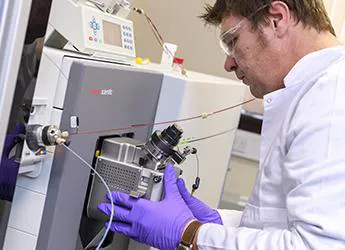The James Hutton institute has invested more than £1.75 million in new laboratory equipment to enhance its independent scientific research capabilities across food, plant, and soil health and quality.
The largest investment is in what is the only one of its kind in Scotland, a combined ultra-high-performance liquid chromatography (UHLC) and high-resolution mass spectrometer (MS).
The high-precision instrument, based at the independent research institute’s Invergowrie campus near Dundee, allows scientists to perform extremely detailed analysis on individual plant and organic compounds faster and with far less manual work than its predecessor machine.

A second machine, based at the institute’s Craigiebuckler campus in Aberdeen, is an advanced scanning electron microscope (SEM), which can image down to nanometre-scale – or a billionth of a meter – plant tissues and other materials.
Dr. William Allwood, metabolomics facility lead at The James Hutton Institute, says that the ThermoFisher UHLC Orbitrap IQ-X high-resolution MS is the most powerful currently available. It allows scientists to separate plant, fruit, vegetable, or processed food extracts into their individual biochemical components.
“With this system, we can compare the content of health-beneficial metabolites, such as vitamins and antioxidants, as well as flavor-relevant compounds, such as those that provide bitter or sweet flavor,” he says.
“That means we can compare the nutritional and flavor quality of fruits, cereal grains, and vegetables that have been grown in different ways, we can assess the effects of storage and processing on foods, and we can also assess the effects of different agricultural practices on the growing plants.
“We can also assess the biochemical impacts of environmental stress, such as drought, flooding or heat, and also plant pests and diseases, helping to identify plant varieties that are resistant or less susceptible to these stressors.”
The new Gemini 300 ZEISS SEM is sensitive enough to allow scientists to obtain high-resolution images of parts of plants down to a nanometre scale. This means they can see, from observing the detailed structure of tissues and cells, how plants react to changes in their environment, from heat stress from climate change to the fertilizer they use, so that plants can be bred for future conditions.
They can also look at what minerals are present and where they are in plants to understand, for example, the nutritional value of its different parts. Scientists can also use this to observe interactions of microplastics with components of the soil.
Additional investments by The James Hutton Institute include a carbon and nitrogen analyzer, used for understanding the content of these elements in soils and plants, which can help to understand how much carbon is being stored in or lost from the soil.
For more information: The James Hutton Institute
The James Hutton Institute
Craigiebuckler Aberdeen AB15 8QH Scotland
Tel.: +44 (0)344 928 5428
info@hutton.ac.uk
www.hutton.ac.uk
